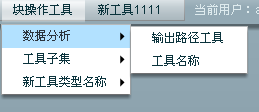main方法里怎么接收servlet返回的值,,返回一个字符串即可
下面的是一个类里面的方法:public static void inputList(String path) {
List<Map<String, byte[]>> datas = getTreeChild(path);
URL url;
try {
System.out.println("开始发送.....");
for (Map<String, byte[]> map : datas) {
Set<String> string = map.keySet();
for (String pathInfo : string) {
String sendPath = getExtName(pathInfo);
// System.out.println(sendPath);
// System.out.println(pathInfo);
url = new URL(actionUrl);
URLConnection con = url.openConnection();
HttpURLConnection httpUrlConnection = (HttpURLConnection) con;
httpUrlConnection.setUseCaches(false);
httpUrlConnection.setDoOutput(true);
httpUrlConnection.setDoInput(true);
httpUrlConnection.setRequestProperty("Content-type",
"application/x-java-serialized-object");
httpUrlConnection.setRequestMethod("POST");
httpUrlConnection.connect();
OutputStream outStrm = httpUrlConnection.getOutputStream();
ObjectOutputStream oos = new ObjectOutputStream(outStrm);
oos.writeObject(sendPath);
oos.writeObject(datas);
oos.flush();
oos.close();
InputStream inStrm = httpUrlConnection.getInputStream();
// String message = httpUrlConnection.getResponseMessage();
// System.out.println(message);
}
}
System.out.println("发送完毕");
} catch (MalformedURLException e) {
e.printStackTrace();
} catch (IOException e) {
e.printStackTrace();
}
}
、、、、、、、、、、、、、、、、、
servlet里面的内容是:
package test;
import java.io.File;
import java.io.FileOutputStream;
import java.io.IOException;
import java.io.InputStream;
import java.io.ObjectInputStream;
import java.io.OutputStream;
import java.util.List;
import java.util.Map;
import java.util.Set;
import javax.servlet.ServletException;
import javax.servlet.http.HttpServlet;
import javax.servlet.http.HttpServletRequest;
import javax.servlet.http.HttpServletResponse;
public class Send extends HttpServlet {
private static final long serialVersionUID = 1L;
@SuppressWarnings("unchecked")
protected void doPost(HttpServletRequest request,
HttpServletResponse response) throws ServletException, IOException {
response.setContentType("text/html");
InputStream inStream = request.getInputStream();
ObjectInputStream objInStream = new ObjectInputStream(inStream);
List<Map<String, byte[]>> list;
try {
// 接收传过来的集合
String oldPath = (String) objInStream.readObject();
String newPath = "E:" + oldPath;
File newDir = new File(newPath);
if (newDir.exists()) {
// System.out.println("传过来的文件已经存在");
// response.getWriter().write("123");
} else {
list = (List<Map<String, byte[]>>) objInStream.readObject();
System.out.println("开始接收数据");
for (Map<String, byte[]> map : list) {
Set<String> string = map.keySet();
for (String path : string) {
String oled = path;
// System.out.println(oled);
// H
String pathDir = oled.toString();
int bb = pathDir.lastIndexOf(":");
String dirPaht = pathDir.substring(0, bb);
// System.out.println(dirPaht);
// 得到文件名前面的路径
path = path.replace(dirPaht, "E");
String beforName = path.toString();
int b = beforName.lastIndexOf("\\");
String bName = beforName.substring(0, b);
System.out.println(bName);
File dir = new File(bName);
if (!dir.exists()) {
dir.mkdirs();
}
File file = new File(path);
OutputStream outputStream = new FileOutputStream(file);
outputStream.write(map.get(oled), 0,
map.get(oled).length);
}
}
System.out.println("接收数据完毕");
}
} catch (ClassNotFoundException e) {
e.printStackTrace();
}
}
}
、、、、、、、、、、、、
怎么传个字符串在上面的方法里面去接收 --------------------编程问答-------------------- 这是啥问题??
包名.类名.inputList("字符串"); --------------------编程问答-------------------- 到底是servlet里传个参数给上面的inputList()方法?还是inputList接收servlet的返回值?
前者直接在servlet里掉,后者你应该没法用main直接得到,你可以把返回值(参数)传到另外一个servlet里,在另外的servlet里调用inputList方法,参数是上一个servlet传过来的 --------------------编程问答-------------------- 你main 和 servlet 怎么扯上关系呢。 --------------------编程问答-------------------- 没清楚你想干什么。。 --------------------编程问答-------------------- servlet可以接收main方法传过来的参数,我的意思就是从servlet返回一个标示,也就是返回一个字符串,然后在main方法里面得到这个字符串,根据返回的值在做判断 --------------------编程问答-------------------- 我把main里面的代码都发出来:主要功能就是实现客户端把附件发送到客户端,然后接收存到指定的路径
package com.phwz.client;
import java.io.File;
import java.io.FileInputStream;
import java.io.FileNotFoundException;
import java.io.IOException;
import java.io.InputStream;
import java.io.ObjectOutputStream;
import java.io.OutputStream;
import java.net.HttpURLConnection;
import java.net.MalformedURLException;
import java.net.URL;
import java.net.URLConnection;
import java.util.ArrayList;
import java.util.HashMap;
import java.util.List;
import java.util.Map;
import java.util.Scanner;
import java.util.Set;
import org.apache.commons.httpclient.HttpClient;
import org.apache.commons.httpclient.NameValuePair;
import org.apache.http.HttpEntity;
import org.apache.http.HttpResponse;
import org.apache.http.client.entity.UrlEncodedFormEntity;
import org.apache.http.client.methods.HttpPost;
import org.apache.http.impl.client.DefaultHttpClient;
public class test {
private static String actionUrl = "http://localhost:8080/Test/Send";
public static void main(String[] args) {
String startPath = null;
System.out.print("请输入磁盘路径:");
Scanner sc = new Scanner(System.in);
String tem = sc.nextLine();// TODO 磁盘路径要根据实际文件夹 的位置输入
if (!(tem.equals("")))
startPath = tem;
inputList(startPath);
}
/**
* 运用递归得到节点数据(文件夹名称和文件名称)
*
* @param parentPath
*/
private static List<Map<String, byte[]>> getTreeChild(String parentPath) {
File file = new File(parentPath);
List<Map<String, byte[]>> list = new ArrayList<Map<String, byte[]>>();
try {
list = findFiles(list, file);
} catch (Exception e) {
e.printStackTrace();
}
return list;
}
/**
* 递归查询所有的文件,并把它读进来然后放到集合里
*
* @return
*/
private static List<Map<String, byte[]>> findFiles(
List<Map<String, byte[]>> list, File file) {
try {
if (file.isFile()) {// 文件
InputStream inputStream = null;
try {
// (int) file.length()
byte[] fileDatas = new byte[1024 * 5];
inputStream = new FileInputStream(file);
inputStream.read(fileDatas);
Map<String, byte[]> map = new HashMap<String, byte[]>();
map.put(file.getPath(), fileDatas);
list.add(map);
} finally {
if (null != inputStream) {
inputStream.close();
inputStream = null;
}
}
} else {
File[] paths = file.listFiles();
for (File childFile : paths) {
findFiles(list, childFile);
}
}
} catch (FileNotFoundException e) {
e.printStackTrace();
} catch (IOException exception) {
exception.printStackTrace();
}
return list;
}
/*
* 发送到指定的servlet
*/
public static void inputList(String path) {
List<Map<String, byte[]>> datas = getTreeChild(path);
URL url;
try {
System.out.println("开始发送.....");
for (Map<String, byte[]> map : datas) {
Set<String> string = map.keySet();
for (String pathInfo : string) {
String sendPath = getExtName(pathInfo);
// System.out.println(sendPath);
// System.out.println(pathInfo);
url = new URL(actionUrl);
URLConnection con = url.openConnection();
HttpURLConnection httpUrlConnection = (HttpURLConnection) con;
httpUrlConnection.setUseCaches(false);
httpUrlConnection.setDoOutput(true);
httpUrlConnection.setDoInput(true);
httpUrlConnection.setRequestProperty("Content-type",
"application/x-java-serialized-object");
httpUrlConnection.setRequestMethod("POST");
httpUrlConnection.connect();
OutputStream outStrm = httpUrlConnection.getOutputStream();
ObjectOutputStream oos = new ObjectOutputStream(outStrm);
oos.writeObject(sendPath);
oos.writeObject(datas);
oos.flush();
oos.close();
InputStream inStrm = httpUrlConnection.getInputStream();
// String message = httpUrlConnection.getResponseMessage();
// System.out.println(message);
}
}
System.out.println("发送完毕");
} catch (MalformedURLException e) {
e.printStackTrace();
} catch (IOException e) {
e.printStackTrace();
}
}
public static String getExtName(String fileName) {
if (fileName == null || fileName.equals("")) {
return null;
}
if (fileName.contains(":")) {
String[] arrFileName = fileName.split("\\:");
return arrFileName[arrFileName.length - 1].toLowerCase();
}
return fileName;
}
}
--------------------编程问答--------------------
 网络编程 ?
网络编程 ?http ,socket ,webservice ?客户端到服务端
补充:Java , Java EE




